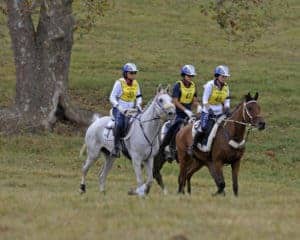
Condition Your Horse Like a Pro
How to help performance horses of all types reach peak fitness.

How to help performance horses of all types reach peak fitness.

No horse is perfect, and many with conformational flaws go on to compete successfully. What can you live with and how?

Do you want to improve your dressage horse’s gait score or emphasize your hunter’s “daisy-cutter” trot? A veterinarian offers insight into how good farriery and strategic shoeing can affect movement.

How do you build a nutritional program that supports your high-intensity equine athlete? Three experts share their advice.

Do you have a cinchy horse? Follow this step-by-step advice to modify his behavior.

In any discipline, cross-training in the key to keeping a horse’s neck and back healthy, says Dr. Kevin Haussler of Colorado State University.

Who you pick as a trainer can make all the difference for your (or your child’s) enjoyment and your horse’s health and welfare. A seasoned equine veterinarian offers her advice on critically evaluating trainers and their programs to find the right fit.

Determining why a horse isn’t performing up to expectations can be a time-consuming and tedious process. One veterinarian shares how she approaches these cases.

Saddle pads are made in a variety of materials for many functions. Find out how they impact your horse.

Here’s a look at the past, present, and future of Thoroughbreds as sport horses.

The Retired Racehorse Project’s 2018 Thoroughbred Makeover took place October 4-7, 2018, at the Kentucky Horse Park. This year’s event featured more than 500 off-track-Thoroughbreds competing in 10 different equestrian sports.

Working with your veterinarian, farrier, and trainer and considering your horse’s physical, mental, and social needs will help you make the best decision for when and how you should transition him to a more leisurely lifestyle.

Rising on the “correct” diagonal on a circle or curve helps counterbalance the horse’s movement asymmetry created by the curve itself. And if the horse is lame, the wrong diagonal could enhance that lameness and the right diagonal could mask it.

No horse is perfect, and many with conformational flaws go on to compete successfully. What can you live with and how?

Researchers determined that, in one study, Western curb bits caused less rein tension than did English snaffles.

Take an inside look at the rules and regulations regarding importing horses to the United States solely for competition.
Stay on top of the most recent Horse Health news with
© 2022 Copyright Statement dolor sit amet, consetetur sadipscing User Terms, sed diam nonumy eirmod tempor invidunt ut labore et dolore magna aliquyam erat, sed diam voluptua. At vero eos et accusam et justo duo dolores et ea rebum. Stet clita kasd gubergren, no sea takimata sanctus est Lorem ipsum dolor sit amet.
"*" indicates required fields